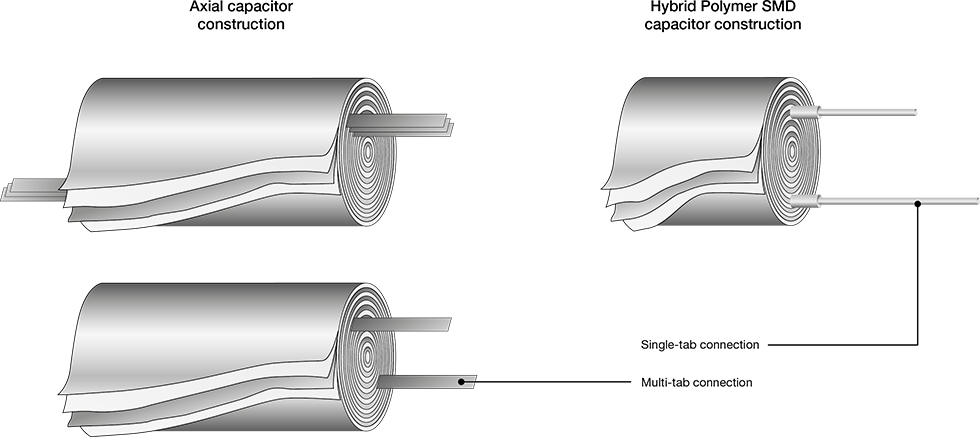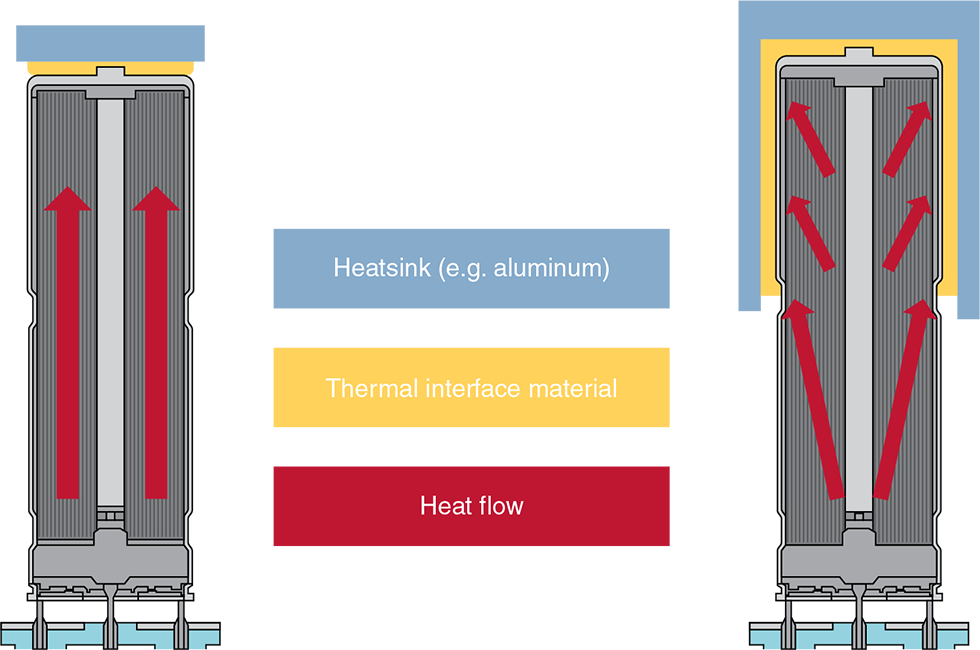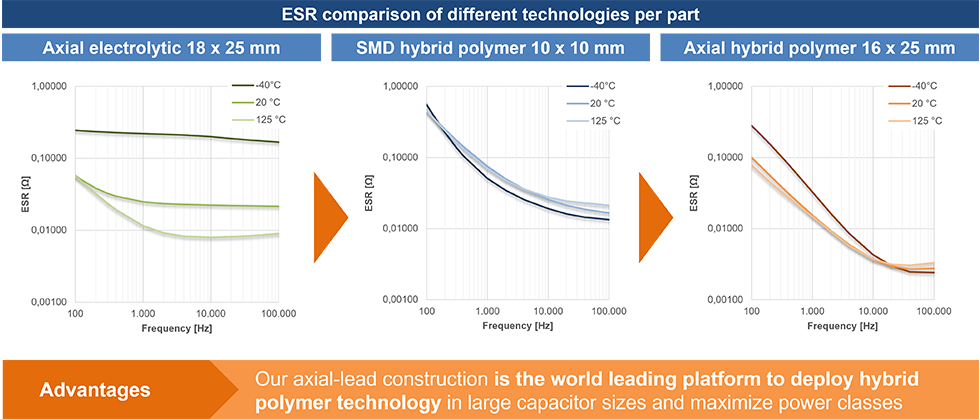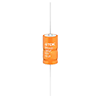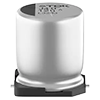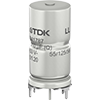High power density solution for DC link on 48 V inverter application with Hybrid Aluminum Electrolytic Capacitors

Contents
Introduction
The market tendency for DC-link capacitors bank for 48 V inverters is clearly toward smaller, more powerful and more efficient devices. Among the available capacitor technologies in the market, Hybrid Polymer Aluminum Electrolytic Capacitors stand out due to their high ripple current density. However, focusing even further on reducing the number of capacitors connected in parallel, TDK’s axial capacitor, with hybrid polymer technology, addresses this matter by enabling streamlined, highly efficient, powerful capacitor bank designs.
Characteristics of TDK's Axial Capacitor with Hybrid Polymer Technology
The following distinctive design properties characterize TDK’s axial capacitor with hybrid polymer technology:
- Hybrid polymer system
- Axial capacitor construction as an enabler
Understanding ESR and Self-heating
To properly distinguish the positive effect of the capacitor design properties on the ripple current capability of the component, the role of capacitor internal series resistance (ESR) and thermal resistance (Rth) has to be understood. The equation below is a simplified approach to describe the capacitor core temperature increase (ΔT) caused by a ripple current (i) applied.
ΔT= i 2×ESR × Rth
Where:
ΔT = capacitor core temperature increase [K]
i = applied ripple current [A]
ESR = Equivalent Series Resistance of the capacitor [Ohm]
Rth = thermal resistance [K/W]
Besides optimizing the thermal model of the component, thus lowering Rth, the ESR is the main parameter to be optimized in order to minimize the capacitor core temperature increase when it is operated with ripple current.
The ESR of a standard aluminum electrolytic capacitor results from the sum of several components as described in the simplified schema shown in Figure 1.
Considering that DC-link inverter applications have switching frequencies (fsw) above 10 kHz, the components of “ESR electrolyte, paper” and “ESR aluminum” become a significant influence on the resulting ESR of the target capacitor; therefore, it is worth optimizing them.
Hybrid Polymer System
To optimize the contribution of “ESR electrolyte, paper” on the capacitor ESR, TDK employs a highly conductive polymer as cathode material in addition to a modified liquid electrolyte, replacing the liquid electrolyte commonly used in Aluminum Electrolytic Capacitors. Figure 2 shows the basic structure as a cross-section of the materials of TDK’s axial capacitor with hybrid polymer technology:
The conductive polymer used in these capacitors is based on PEDOT: PSS material (Figure 3). It achieves conductivities in the range of 1000 S/cm, while standard electrolytes are in the range of 0,01 S/cm.
Despite its excellent conductivity properties, PEDOT: PSS is a material with challenging characteristics to process, and, the larger the capacitor is, the more complex the process gets. To realize the can size range of axial capacitors, TDK has developed a patented process to achieve good impregnation of the polymer in the foils and papers. Therefore, TDK’s axial capacitors with hybrid polymer technology achieve larger sizes, thus remarkably more significant ripple current specifications than the existing parts in the market.
Additionally, to the conductive polymer, a modified electrolyte with reinforced structure, also patented by TDK, is used in the capacitor to protect the polymer layer and provide regeneration feature to the oxide during the capacitor lifetime.
Axial capacitor construction as an enabler
Due to the application of hybrid polymer technology, the ESR caused by “ESR electrolyte, paper” is remarkably reduced. Therefore, the contribution of “ESR aluminum” becomes dominant and shall be minimized to increase the component’s overall ripple current capability.
The axial capacitor construction provides an excellent platform for deploying multiple connections to anode and cathode foils, thus minimizing the ESR of a single component. Figure 4 shows a comparison between winding construction of hybrid polymer SMD capacitors and axial capacitors with hybrid polymer technology, pointing out how multiple connections (multi-tab) are applied to axial windings:
An additional advantage of axial capacitors is the thermal characteristics of the component. The winding element has a metal-to-metal connection to the aluminum housing providing a more efficient path to dissipate the internal heat to an outside heat sink attached to the capacitor’s case. Due to its stable mechanical construction, axial capacitors with hybrid polymer technology also provide high internal vibration stability. This construction can achieve internal vibration stability up to 60 g, provided the case rigidly clamps the capacitor.
ESR comparison of relevant technologies
To verify the ESR performance of the hybrid polymer axial capacitors, measurements against relevant candidate capacitors [1,2,3] for DC-link position was performed and the results are presented in Figure 6. As a result, the remarkable advantage of Axial Hybrid Polymer Capacitors is verified by ESR measurements.
Conclusion
Axial Hybrid Polymer Capacitors are mainly targeted at higher power class 48 V inverters, for example, 15 kW and up, where the RMS ripple current for the DC-link capacitor bank is in the range of 150 Arms for continuous application and short periods can reach values of 300 Arms.
In such application scenarios, the DC-link capacitor bank is usually subject to a liquid cooling system to cope with the high capacitor self-heat due to ripple current requirements. Due to its excellent thermal and lower ESR characteristics, it is possible to design a DC-link capacitor bank with a minimized component count by applying Axial capacitors with hybrid polymer technology.
When designing such a capacitor bank, some factors must be considered as they can affect the size of the capacitor bank.
One factor is the switching frequency. Axial capacitors with hybrid polymer technology from TDK are specified for a frequency of 20 kHz. Other technologies have their ripple current specified for different frequency ranges. For example, SMD Hybrid Polymer Capacitors are set for 100 kHz, whereas standard Aluminum Electrolytic Capacitors are typically set for operation above 10 kHz.
The other important factor is useful life. Due to their robust construction, Axial Hybrid Electrolytic Capacitors can withstand higher internal temperatures for longer than standard Aluminum Electrolytic Capacitors and SMD Hybrid Polymer Capacitors. The ability to withstand higher internal temperatures for a more extended time is directly translated to higher ripple current handling capability.
Considering a reference lifetime of 4000 h with the case temperature held at 125°C, the comparison chart shown in Figure 7 can be made: Based on the comparison results, it is possible to observe that TDK’s axial capacitors with hybrid polymer technology can reduce the component count in the DC-link capacitor bank.
References
| Axial Hybrid Polymer Capacitors | SMD Hybrid Polymer Capacitors | Axial Electrolytic Capacitors | |
|---|---|---|---|
| Series | B40640 / B40740 series | B40940 series | B41687 / B41787series |
Related Links
Product Portal

- Hybrid Polymer Capacitors Product Information
- A comprehensive guide to information on Hybrid Polymer Capacitors from the TDK Group.

- Axial Capacitors Product Information
- A comprehensive guide to information on Axial Capacitors from the TDK Group.

- SMD Capacitors Product Information
- A comprehensive guide to information on SMD Capacitors from the TDK Group.




